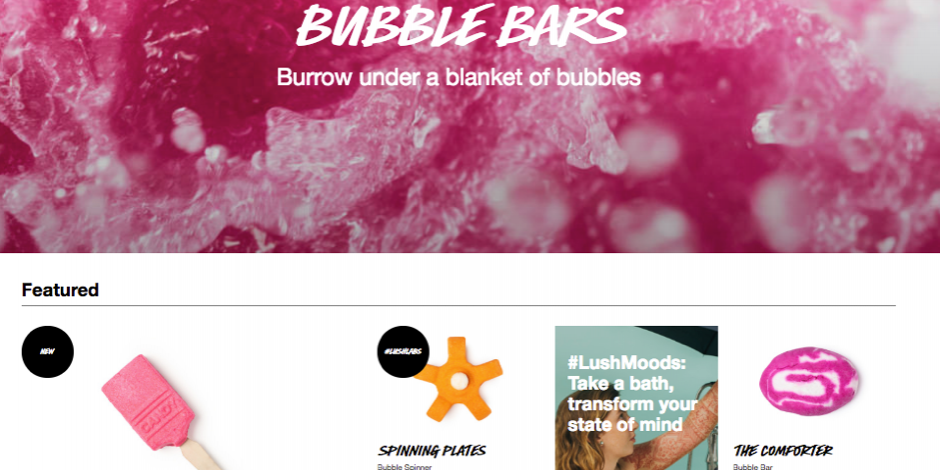A guide for writing stellar category content
The marketing sector can be a complicated place as new marketing tools and techniques are launched, almost on a weekly basis. Powered by The Drum Network, this regular column invites The Drum Network's members to demystify the marketing trade and offer expert insight and opinion on what is happening in the marketing industry today that can help your business tomorrow.

Zazzle Media on crafting effective eCommerce copy and getting the most out of SEO keywords.
Category content is essentially a paragraph that traditionally sits at the top of a webpage. It’s the first bit of text your user will see on any retail or eCommerce site, when they click into a category of pages, such as in the lead image above. In this example from Lush – the category is Bubble Bars, but the ‘category content’ is ‘Burrow under a blanket of bubbles’.
It has two main functions:
The first is to utilise its SEO potential by hitting keywords.
The second is to explain to potential customers what the purpose of the page is to get them to convert.
Whether you're looking to grow your online presence or grow your revenue, here are ten quick tips to help you craft better targeted, engaging category content.
1) Find out the page’s intent
The first thing you need to do when writing category content is to find out what you want to say. What is the aim of the page? Does it contain products you wish to sell? For example, are you creating content for the product page of an online shoe shop or is it a purely informational business, such as a financial advice service? This will change the way you present the initial introduction to the page.
2) Include keywords
The only way your content is going to improve its position on Google is with relevant and effective keywords. If you don't have access to a snazzy SEO team or big budget software, websites such as Ahrefs, there are free options like Answer The Public and even Google Trends to help you narrow down keywords that are relevant to your user's journey.
3) Use your tone of voice
All brands should have a tone of voice – settling on a recognisable tone is key for branding across digital and traditional marketing methods, and all your marketing efforts should consistently convey this tone. If you haven’t covered this yet, start with this blog which should help you get started crafting a suitable tone.
Whether you’re a finance company or a travel website, your tone of voice will help you talk and connect with your audience. If your tone is more formal, stay reserved in your category content. If it’s jovial and chatty, your category content can be more relaxed.
4) Have a word count
You don’t need to write an essay for the content to be fit for purpose. In fact, in some cases, waffling on can hide the page’s intent and make it harder for Google to read. We’d recommend your word count lie between 70-250 words but you should always include several relevant keywords.
5) Be clear and consistent
You don’t want to over-explain the page’s purpose, as this can come across too rigid and uninteresting. It’s OK to imply and assume that the potential customer can figure the rest out considering your products are visible too. Use active words and be direct. A reduced word count could help you create concise copy.
6) Use internal links sparingly
Relevant internal links are a great tool to use to give your page authority while helping the user navigate around your website easily. This is particularly useful for clothing websites where there are lots of products per page. But, don't overdo these links; use them sparingly. A maximum of two per pages will suffice.
7) Include a call to action
You can include a call to action within your category content. This can help give the page context and an incentive or instruction for your consumers to follow. Whether that's a money-back guarantee promise or delivery information, it adds in practical detail to help convince customers to make a purchase or use your services.
8) Check how your competitors do it
Look at your competitors to see how they do category content and figure out how to do it better. Analyse what they're doing well and what they're doing badly, especially if they're ranking higher on Google than you. But, do remember that this doesn't mean you should directly copy their content. You'll want to create authentic category content that's tailor-made to your brand (remember your tone of voice).
As well as your direct competitors, search for the top-ranking businesses against the keyword you're trying to rank for. This way you won't miss anything when you're trying to look for ways to improve your own category content and rankings.
9) Keep it interesting
It can be all too easy to fall into the trap of a template, which can make your category content boring and repetitive. However, it can be a good idea to have a rough format to stick to as it can help you include all the needed information until you get the hang of it.
Remember to use your tone of voice to vamp up your content.
Take a look at how footwear company Schuh writes theirs: "When it comes to trainers, we firmly believe that retro is best. For sneakers with stories, to profiles with personality, you’ve come to the right place for a pair of men's classic trainers from brands like Adidas, Nike, FILA and PUMA. Choose from our range of gum sole trainers, men’s vintage Adidas trainers or 90s icons like FILA and the Nike Tekno. Nostalgia is a wonderful thing, so order your men’s retro trainers before 10pm* for Next Day UK Delivery."
Schuh has used their casual, knowledgeable tone of voice to create this 80-word category content that includes both a CTA and internal links as well as hitting relevant keywords.
10) Measure this success
After uploading any new category content, you should always see how well it performs and ranks against the keywords. This way you're able to make changes when necessary to continue to improve your site and attract new customers in the process. KPI’s to note here will include clicks and conversion rates, and you can monitor user journeys and pathways on GA. You can read more about how to monitor eCommerce site performance here. Analytics will be your best friend throughout this process, to ensure you iterate and learn from every change.



 Print the article
Print the article



